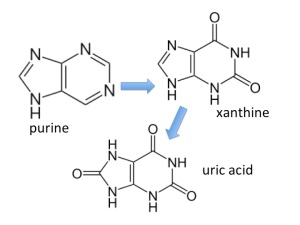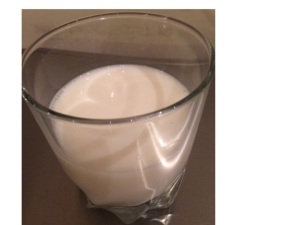I hope I never get gout. We see someone with this problem maybe once a month on our admissions unit. The usual story is a middle-aged or elderly person with a fairly sudden onset of severe joint pain. Usually gout can be managed at home, but last week we admitted George, a 68-year-old man living on his own. He had managed to look after himself reasonably well since his wife died last year, but now could not walk because of the excruciating pain in the big toe of his left foot.
Before he came in, George had been fairly well apart from mildly raised blood pressure, for which he took a tablet of bendroflumethazide – a thiazide diuretic.
On the day of admission he had been hopping around the bathroom, slipped and fell against the bath, breaking his arm. As he was describing this I looked at the junior doctor who was with me – she was almost giggling. I gave her a stern look. This conjured up a comical scene, but George did not find it funny.
George had managed to crawl slowly and painfully to the bedroom and call the ambulance. In the emergency department he had complained much more about the pain in his foot than his broken arm. He was very reluctant to let us look–
“don’t touch it – please”.
He had podagra, a wonderful word for gout affecting the first metatarsal-phalangeal joint (the one where bunions appear). For years I’ve been wanting to use the word podagra in Scrabble but not yet got the right letters.
George’s big toe was swollen and red – we did not need to examine it to see how tender it was. The inflammation was caused by the usual culprits – neutrophils. They had been summoned not by germs or allergens, but in this case by crystals of uric acid deposited in the toe joint causing damage to the synovial membrane.
Uric acid is made from purines. You may remember from high school biology that DNA is principally made from four bases A,T,C and G. Cytosine and thymine are pyrimidines, while adenine and guanine are the bigger purines.

A lot of the food we eat contains DNA, whether we are meat-eaters or vegetarians, so we continually have to get rid of the purines. Our bodies also can make the DNA bases from simpler molecules, and unless we are growing or pregnant, we have to get rid of those too.
In humans purines are broken down to xanthine (pronounced zantheen) and then, via the enzyme xanthine oxidase to uric acid. Most other animals, apart from primates, take it further and turn uric acid into allantoin via the enzyme uricase. Allantoin is more soluble and more easily excreted. It is not clear why evolution has decided that we humans do not need this final step, which would make sure we never get gout. There has been the suggestion that uric acid is an important antioxidant which helps protect us – more recently others have suggested that uric acid, or urate is damaging.
What is clear is that fructose is important. Fructose is a sugar which is found in fruit juice and honey – sounds very healthy. But there is now increasing evidence that fructose is bad for us, at least in the large quantities we are now consuming.
Table sugar or sucrose is half fructose. It is a di-saccharide, one molecule of glucose and one of fructose joined together. Fructose is not metabolised in the same way as glucose.

It is converted straight away to fat – triglycerides. The pathway involves the addition of a phosphate group to fructose by the enzyme fructokinase. This uses adenosine triphosphate (ATP), and it seems that the adenosine used in this pathway is then broken down and converted, via xanthine oxidase, to uric acid.

George used to drink at least a glass of sweetened orange juice and two or three cans of coca-cola every day. This ensured he had plenty of fructose which increased his uric acid production, and the thiazide diuretic reduced his kidneys’ ability to excrete it.
As well as increasing uric acid production, fructose seems to promote the formation of intra-abdominal fat. If Robin Lustig is to be believed, fructose, derived from  sucrose and high fructose corn-syrup, is much more important than saturated fat in causing obesity, diabetes and vascular disease. His videos and book are worth looking at:
sucrose and high fructose corn-syrup, is much more important than saturated fat in causing obesity, diabetes and vascular disease. His videos and book are worth looking at:
The food link this week is milk.
What really interests me is that milk contains loads of the enzyme xanthine oxidase – the enzyme which converts xanthine into uric acid. Much more than anywhere else in the body. Why on earth would you need this enzyme which converts xanthine to uric acid in milk? It seems that this enzyme can do other things apart from oxidising xanthine, it can also generate some of the toxic compounds such as superoxide which we previously saw being used by neutrophils to kill bacteria.

Now this is just a theory – but if you happen to be a research microbiologist maybe you can test it. Milk is a suspension of fat globules in a protein-rich watery soup. But not ordinary fat globules. Each tiny blob of fat in milk is covered by a a complex phospholipid trilayer in which is embedded lots of xanthine oxidase enzyme.
The theory I’d like to put forward is that nasty bacteria like salmonella, which cause gastroenteritis by invading and attacking the cells which line our intestine, will also attack milk fat globules. Milk globules have some of the same proteins in their outer membrane as intestine cells.

When they attack they activate the xanthine oxidase enzyme which generates superoxide which will eventually kill them. Non-invasive, non-agressive germs which we want to colonise our guts such as commensal E.coli and lactobacilli would not activate the enzyme and be allowed to survive. It is only an hypothesis at the moment, but would seem to be a great way to make sure that new-born infants, when fed on breast milk with lots of xanthine oxidase, get the right germs in their guts. We know that babies fed on formula, which contains less xanthine oxidase are more likely to get problems with diarrhoea.
It would also explain why yoghurt, which is made by deliberately allowing germs to breed in it, only very rarely contains nasty germs such as salmonella (although there is the notorious case of a batch of hazlenut yoghurt which had botulinum toxin – clostridium botulinum causes problems by synthesising a toxin, not by physically attacking cells).
For the story see:
